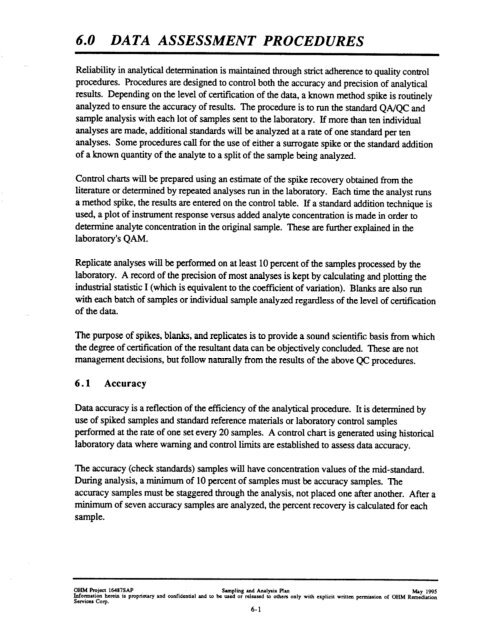work plan for soil remediation, sampling and analysis plan, site ...
work plan for soil remediation, sampling and analysis plan, site ...
work plan for soil remediation, sampling and analysis plan, site ...
You also want an ePaper? Increase the reach of your titles
YUMPU automatically turns print PDFs into web optimized ePapers that Google loves.
6.0 DATA ASSESSMENT PROCEDURESReliability in analytical determination is maintained through strict adherence to quality controlprocedures. Procedures are designed to control both the accuracy <strong>and</strong> precision of analyticalresults. Depending on the level of certification of the data, a known method spike is routinelyanalyzed to ensure the accuracy of results. The procedure is to run the st<strong>and</strong>ard QA/QC <strong>and</strong>sample <strong>analysis</strong> with each lot of samples sent to the laboratory. If more than ten individualanalyses are made, additional st<strong>and</strong>ards will be analyzed at a rate of one st<strong>and</strong>ard per tenanalyses. Some procedures call <strong>for</strong> the use of either a surrogate spike or the st<strong>and</strong>ard additionof a known quantity of the analyte to a split of the sample being analyzed.Control charts will be prepared using an estimate of the spike recovery obtained from theliterature or determined by repeated analyses run in the laboratory. Each time the analyst runsa method spike, the results are entered on the control table. If a st<strong>and</strong>ard addition technique isused, a plot of instrument response versus added analyte concentration is made in order todetermine analyte concentration in the original sample. These are further explained in thelaboratory’s QAM.Replicate analyses will be per<strong>for</strong>med on at least 10 percent of the samples processed by thelaboratory. A record of the precision of most analyses is kept by calculating <strong>and</strong> plotting theindustrial statistic I (which is equivalent to the coefficient of variation). Blanks are also runwith each batch of samples or individual sample analyzed regardless of the level of certificationof the data.The purpose of spikes, blanks, <strong>and</strong> replicates is to provide a sound scientific basis fi-om whichthe degree of certification of the resultant data can be objectively concluded. These are notmanagement decisions, but follow naturally from the results of the above QC procedures.6.1 AccuracyData accuracy is a reflection of the efficiency of the analytical procedure. It is determined byuse of spiked samples <strong>and</strong> st<strong>and</strong>ard reference materials or laboratory control samplesper<strong>for</strong>med at the rate of one set every 20 samples. A control chart is generated using historicallaboratory data where warning <strong>and</strong> control limits are established to assess data accuracy.The accuracy (check st<strong>and</strong>ards) samples will have concentration values of the mid-st<strong>and</strong>ard.During <strong>analysis</strong>, a minimum of 10 percent of samples must be accuracy samples. Theaccuracy samples must be staggered through the <strong>analysis</strong>, not placed one after another. After aminimum of seven accuracy samples are analyzed, the percent recovery is calculated <strong>for</strong> eachsample.OHM Project 16487SAp Sapling <strong>and</strong> Analysis <strong>plan</strong> May 1995In<strong>for</strong>mation herein is proprietary <strong>and</strong> confidential <strong>and</strong> to be used or released to othen only with explicit written pcmission of OHM Ram&&n&m&a Corp.6-1
















